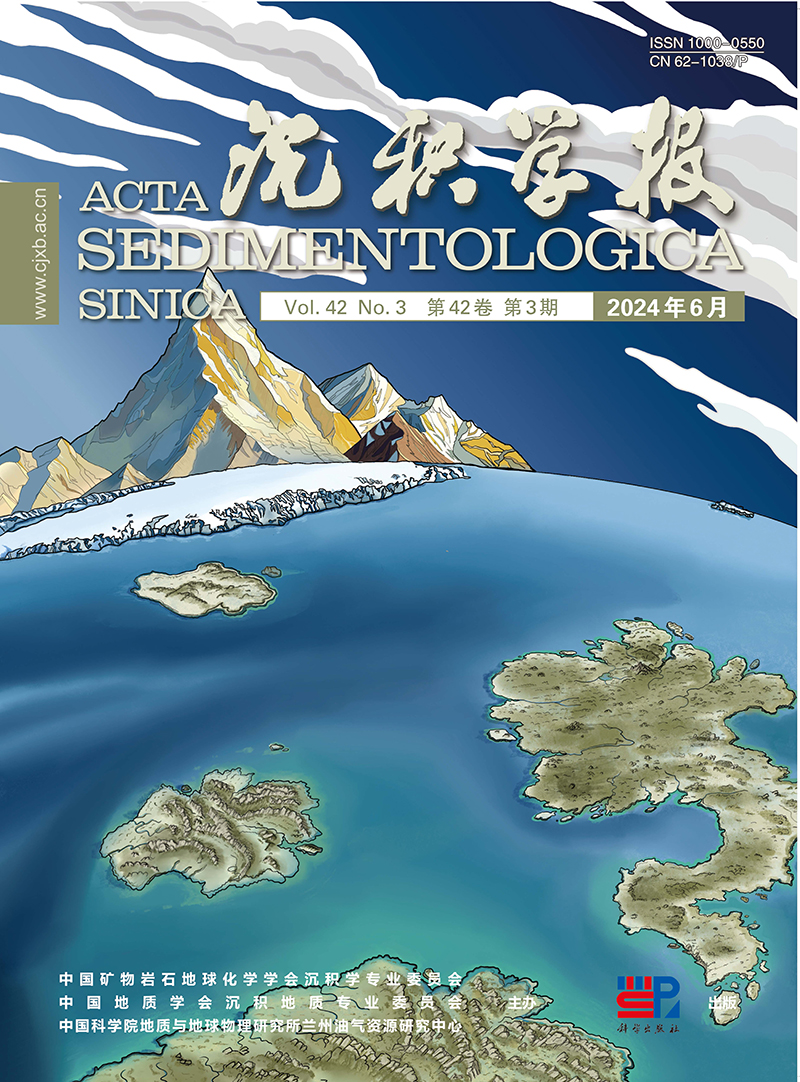HTML
-
中世纪气候异常期(Medieval Climate Anomaly,MCA)[1]与小冰期(Little Ice Age,LIA)[2]的气候环境变化特征对于预测未来人为成因的全球变暖环境变化至关重要。由于全球和区域气候环境变化的复杂性[3⁃4],利用多种重建资料刻画MCA和LIA的区域变化特征非常必要。目前,已有众多古气候记录表征了这两个特征期在全球不同区域的起始时间和干湿特征,多数研究认为MCA发生于9—14世纪,而LIA可能发生于15—19世纪[5⁃6]。然而,受重建资料以及区域差异性等因素的影响,我国不同区域气候记录显示的MCA向LIA的转变时间存在差异。例如,北方开元洞石笋记录显示MCA至LIA的转变发生于1 482 A.D.[7];而西北地区的中泉子湖记录显示这两个特征期的转变发生于1 300 A.D.[8];在我国西南地区,泸沽湖多指标记录显示大约1 300 A.D.为MCA至LIA的转变时期[9]。在两个时期干湿变化特征方面,我国季风气候区的多数研究认为普遍存在南北偶极型的降水模式,MCA和LIA时期南北方大致呈现相反的干湿格局,即MCA时北方湿润,南方干旱,而LIA时北方干旱,南方湿润[10⁃12],表现出显著的季风降水空间差异。但某些局部区域的干湿特征在两个气候特征期的表现并非所期望的那样[13⁃14]。而造成此种气候特征变化的原因可能是太阳活动外部驱动与地球内部变化如热带辐合带(Intertropical Convergence Zone,ITCZ)、厄尔尼诺—南方涛动(El Niño-Southern Oscillation,ENSO)等因素共同作用的结果[10,15⁃16]。因此,进一步细化明确MCA和LIA在小区域尺度上发生时间和空间特征的异同性,厘清MCA和LIA的时空变化特征,有助于提高对这两个气候特征期动力机制的理解和对未来气候变化的预测。
过去着重利用石笋代用指标中的δ18O重建气候环境的变化,多数研究认为δ18O主要反映了夏季风整体强度的变化,并非洞穴地点的水文环境变化[10,17]。局域生态环境特征与区域水文气候变化紧密联系,近年来已有大量研究表明石笋δ13C在重建局域生态环境和水文气候上具有潜力[18⁃21]。我国不同区域石笋研究均有报道石笋δ13C与局域水文气候存在密切联系,能够较好地反映局域生态环境演化。最近,西北万象洞石笋δ13C在数十年—百年尺度上主要与区域水文相关的土壤湿度平衡和植被密度有关[20];而东南地区多个洞穴石笋δ13C研究表明δ13C能够较好地反映长江中下游区域的旱涝特征,结合石笋高精度定年和高分辨率的特征,进一步明确古文化演化阶段与水文气候变化之间的联系[22]。此外,长江中游地区和西南地区多个洞穴石笋δ13C的研究均表明δ13C能很好地响应于局域水文气候的变化,进而表征洞穴区域生态环境演化[18,23]。因此,石笋δ13C记录是δ18O记录表征季风水循环的有效补充,二者从不同侧面反映季风水循环的变化过程。而对于MCA和LIA的气候特征变化,石笋δ13C的研究也将有助于进一步提升对两个气候特征期的理解。例如,陈朝军等[11]利用贵州地区多支石笋δ13C记录探究了过去2 000年以来西南地区洞穴上部地表生态环境的变化,发现δ13C从MCA至LIA持续偏重,认为气候变化与人类南迁的共同影响导致了该地区石漠化的扩张。然而,在南方与北方交界的长江中游地区,MCA和LIA的气候环境特征还存在争议[24⁃25],MCA向LIA的转变时间尚未明确。此外,长江中游与贵州地区的石笋δ13C记录在MCA和LIA时期是否一致变化,在一定程度上可以验证人类南迁导致地表环境变化的认识。
选用湖北省永兴洞两支高分辨率石笋δ13C记录,探讨MCA和LIA的气候环境特征,刻画MCA向LIA的转变时间和特征,并通过与其他记录对比尝试理解MCA与LIA时期长江中游地区气候环境变化的原因。该研究对进一步明确我国MCA与LIA的气候环境时空分布特征有一定的补充意义。
-
采用部分时段重叠的两支石笋(YX262和YX275)[26⁃28],这两支石笋采自湖北省神农架保康县歇马镇永兴洞(31°35′ N,111°14′ E;洞口海拔高度约800 m)。洞穴上覆植被为多年生木本和灌木丛草本[26⁃27,29],洞内温度为14 ℃,相对湿度接近100%[30⁃31]。该洞地处亚热带季风气候区,夏季受来自低纬的水汽影响显著。1981—2010年保康县降水记录显示,此区域年均降水量约930 mm,70%的降水主要分布在夏季风盛行的5—9月[29]。
YX262和YX275石笋均采集于洞穴深部,长度分别为159 mm和120 mm,主要由方解石构成。两支石笋的碳氧同位素及年代样品的取样及相关测试方法见文献[26]和[28]。肉眼观察和U/Th年龄显示这两支石笋沉积连续,不存在明显的沉积间断[26⁃28]。已报道的氧同位素在重叠时段有较好的重现性[26,28](图1a),暗示两石笋在沉积过程中同位素分馏平衡,受非气候因素影响较小[26,32],可用于重建古气候环境演变。
-
YX262和YX275石笋共测定了13个U/Th年龄[26,28]。整体上,两支石笋238U含量较高,232Th含量偏低,导致测年误差较小,为4~19年。为了更好地拼接两支石笋记录,二者时标均由Mod-Age模式[33]建立(图2)。年龄—深度模型结果显示,YX262沉积于1 027~1 639 A.D.,持续时间约612年,平均分辨率为3.8年;YX275沉积于1 361~1 955 A.D.,持续时间约594年,平均分辨率为5年。此外,模型结果显示这两支石笋生长速率均较为匀速(图2),说明同位素曲线变化形态及其所指示的局域地表环境和气候变化受测试年龄数目的影响较小。
-
分别测试了YX262和YX275石笋120组和159组碳氧同位素数据[26⁃28],并将未报道的YX262 δ13C数据和已报道的同位素数据结合,研究了长江中游地区气候环境变化及可能的驱动机制。鉴于两支石笋的碳氧同位素记录在重叠时段呈现出较好的一致性,为消除不同记录间相对幅度变化的偏差以获取更长时间序列的综合记录,利用ISCAM(Intra-Site Correlation Age Modelling)程序[34],分别将这两支石笋的δ13C与δ18O序列进行拼接(图3)。此程序能够有效地消除不同石笋同位素记录之间人工拼接时相对幅度变化的差异,有助于研究拼接记录在不同时间段的相对幅度变化。

Figure 3. Composites of oxygen and carbon isotope records of stalagmites YX262 and YX275 in Yongxing cave
拼接合成的δ13C与δ18O记录的时间跨度为1 044~1 954 A.D.,共持续910年,包含MCA和LIA两个气候特征期。δ18O值在-9.24‰和-7.79‰之间波动,变幅为1.45‰,平均值为-8.50‰。δ18O值在MCA时期较LIA整体偏负,在MCA内部,δ18O呈现逐渐负偏特征,LIA期间δ18O显示出明显的数十年—百年尺度的振荡[26](图3a);相对于δ18O,δ13C的变化幅度较大,达2.78‰。δ13C在-12.12‰~-9.34‰范围内波动,平均值为-10.77‰。δ13C较为明显的特征是,在MCA向LIA转变的时期,其值呈现出明显的均值突变。在MCA时期,δ13C值相对偏负,虽然存在数十年尺度的振荡,但并未呈现出明显的长期趋势。而在LIA时期,δ13C值相对偏正,也未呈现出显著的变化趋势(图3b)。总体而言,δ13C与δ18O变化较为相似,均显示MCA时整体负偏,而LIA时整体正偏。然而不同的是,MCA时期二者的变化趋势存在差异,δ18O呈现逐渐偏负的特征,而δ13C在-11.08‰附近上下波动(图3)。
2.1. 年代
2.2. 石笋δ13C与δ18O记录
-
随着洞穴监测以及模拟技术不断发展,石笋δ13C被证明对局域生态环境与气候的响应十分敏感[36⁃37]。在不同时间尺度上,石笋δ13C所反映的气候环境特点存在差异,轨道尺度上石笋δ13C的变化主要是由植被类型的自然更替而引起的[38],而在千年—百年尺度上石笋δ13C的变化可能与局域生态水文环境有关[11,18,20]。此外,区域的差异性以及沉积过程的复杂性也使得石笋δ13C在不同的背景下产生一定的差别[39-40]。在长江中游地区,牛洞[23]、落水洞[41]、玉龙洞[21]、和尚洞[42]等众多的洞穴石笋δ13C被认为是局域生态环境和水文气候变化的重要代用指标。因此,同区域的永兴洞石笋δ13C可能同样反映了局域生态水文环境的变化。即当降水量丰富时,植被生长茂盛,密度大,植物根系的呼吸作用和微生物活动增强,生物量增加,土壤CO2产率增大,促使土壤中12C相对富集,土壤富集的12C通过雨水的溶解,形成Ca(HCO₃)₂溶液,致使石笋δ13C值偏负[39,43⁃44]。此外,降水量大时引起水—岩相互作用的时间缩短,围岩(δ13C值较重)溶解变少,石笋δ13C亦相对负偏[27,44]。反之,降水量减少时,植被生物量的减少以及围岩溶解的增加均导致石笋δ13C的正偏。
石笋δ13C与文献资料的对比,进一步证实了石笋δ13C变化与局地水文环境变化的关联性。永兴洞石笋δ13C与历史资料重建的宜昌地区近500年来的旱涝指数序列具有很好的一致性[45](图4a)。因永兴洞数据平均分辨率约为4.4年,而旱涝指数时间序列的分辨率为1年,因而通过等间距内插将这两个序列的分辨率统一调整为4年,再进行5点滑动平均。相关性计算结果表明,石笋δ13C与旱涝指数的相关性达0.56(N=116,P<0.01)。如图4a所示,当旱涝指数小于3时,表示宜昌地区较为湿润,对应石笋δ13C偏负;而当旱涝指数大于3时,表示宜昌地区较为干旱,对应石笋δ13C偏正。石笋δ13C能够反映局地水文环境的变化还得到石笋生长速率的支持,δ13C负偏时石笋的生长速率较快,而δ13C正偏时石笋的生长速率较慢(图4b)。如石笋YX262的生长速率从MCA至LIA表现出明显的递减模式。此外,永兴洞石笋δ13C和δ18O在年代尺度上存在较好的相关性(R=0.46,N=279,P<0.01),暗示δ13C和δ18O的变化可能具有相同的强迫机制。尽管对石笋δ18O的理解还未取得一致看法[46],但最近研究成果显示石笋δ18O主要反映了大尺度季风环流及其影响的降水变化[47]。基于以上论证,永兴洞石笋记录很可能受局域水文气候变化的影响。然而,除自然因素影响外,一些洞穴石笋δ13C值在数十年或数百年尺度的突然增大与人类活动有关,人口增加、森林砍伐、土地垦殖等会改变土壤有机环境,从而影响石笋δ13C的变化[48⁃49]。Zhang et al.[48]基于我国东部两支石笋δ13C的研究,发现在700~1 100 A.D.δ13C的异常增大与安史之乱爆发后人口大量南迁有关,人类的毁林开荒改变了地表的生态环境,促使δ13C增大。
-
永兴洞石笋δ13C序列显示MCA与LIA时期呈现出两种完全不同的气候特征。MCA时期石笋δ13C整体偏负,而LIA时期整体偏正(图5a)。这与陈朝军等[11]研究的西南地区石将军洞石笋δ13C具有一定的相似性(图5b)。此外,同属于长江中游地区的湖北犀牛洞[50]、落水洞[51]以及湖南莲花洞[52]石笋δ13C均显示了MCA时期偏负而LIA偏正的特点(图5c~e)。虽然这些记录在数十年—百年尺度的振荡上存在差异,但仍然能够辨别各个记录在MCA与LIA 时期不同的气候特征。
依据上文对石笋δ13C的理解,MCA与LIA时期不同的气候特征呈现了该地区清晰的水文环境变化。MCA时期δ13C平均值为-11.1‰,整体负偏;LIA时期δ13C平均值为-10.4‰,整体正偏,表明长江中游地区存在湿润的MCA和相对干旱的LIA(图6)。长江中游其他记录也呈现了相似的气候环境变化特征。利用多指标以及数学模型建立的中国中部地区夏季降水量变化记录[53]显示(图6),月降水量变化的平均值在MCA时期为4.6 mm,在LIA时期为3.0 mm,指示MCA时期长江中游地区水文气候较为湿润,而LIA时期相对干旱。该水文环境变化特征也得到植物孢粉证据的支持。江西玉华山乔灌木花粉百分比[54]在MCA时较大,而LIA时较小,表明MCA时较为湿润,LIA则与此相反(图6)。此外,湖北地区岩心中的植物生态记录[57]同样支持了此观点。尽管过去研究显示我国南北方MCA和LIA呈现出相反的降水格局,北方MCA湿润而LIA干旱[10,58],南方MCA干旱而LIA湿润[12]。然而,位于我国南北方过渡带的湖北石笋δ13C显示出与北方类似的水文环境变化。需要指出的是,与永兴洞石笋δ13C记录反向的水文环境模式也在长江流域有所报道。如湖北大九湖[25]和浙江千亩田泥炭记录[59]显示了干旱的MCA和湿润的LIA,而这种差异可能与山地海拔效应以及MCA和LIA时期不同的气温背景[60]有关。大九湖盆地海拔高度介于1 700~1 760 m[61],千亩田海拔高度约为1 338 m[59],两地海拔高度均显著高于永兴洞(800 m)。可能在MCA时期,较高的北半球气温引起大气水汽含量显著增加,在山地低海拔区域受地形雨的影响更易形成降水;而在LIA时期,较低的北半球气温造成大气水汽含量降低,在山地高海拔区域受地形雨的影响更为显著。此外,LIA时高海拔区域气温低,蒸发弱,湿度高,可能在一定程度上造成这些记录呈现出与永兴洞相反的降水模式。

Figure 6. Comparison of the stalagmites δ13C record in Yongxing cave with other records in the middle and lower reaches of the Yangtze River
永兴洞石笋δ13C清晰地记录了MCA向LIA的快速转变特征和起止时间。利用Rampfit算法[35]对永兴洞石笋碳氧同位素记录进行了趋势变化分析(图3),结果显示,永兴洞石笋δ13C与δ18O在MCA向LIA转变时有明显的快速变化,但存在差异。MCA向LIA转变期间,石笋δ18O迅速偏正1.01‰,时间跨度为1 423~1 516 A.D.,中间点年龄为1 469 A.D.,持续时间为93年(图3a);石笋δ13C显示此转变开始于1 434 A.D.,结束于1 460 A.D.,中间点年龄为1 447 A.D.,持续时间为26年,变化幅度达1.31‰(图3b)。δ13C的均值突变晚于δ18O变化约10年,可能反映了局地生态水文状况对大尺度大气环流的调整和响应。δ13C的快速变化和其在MCA和LIA期完全不同的均值状态,暗示了长江中游地区MCA与LIA的划分界线约在1 447 A.D.。
MCA至LIA水文状态的快速转变除了受气候变化影响外,人类活动的影响也不容忽视。Lan et al.[8]基于季风边缘区的多指标记录,认为季风强度在MCA向LIA转变期的快速减弱是对太阳总辐照度减小及其引起的大气环流变化的非线性响应。而在人类活动影响方面,永兴洞石笋δ13C的快速转变可能与明朝洪武三年(1 370 A.D.)至永乐十五年(1 417 A.D.)发生的明初大移民事件相关,其中“江西填湖广”的移民活动规模极大[62]。大量的移民涌入湖北,必然造成大规模的森林砍伐和土地开垦,从而改变了地表植被生态环境,最终造成了区域性的δ13C突然偏重[11]。历史文献资料重建的湖北省耕地面积的变化也支持人类活动加强的认识。如图6所示,1 400 A.D.左右湖北省耕地面积快速增加[55],可能是大量的人口涌入使得粮食的需求量增大,土地垦殖面积增加[62]。同样,Xiao et al.[56]利用湖北太白湖沉积物多指标记录,基于数理统计的去趋势对应分析方法,所得的轴1得分被认为是人类活动强度的指标,即轴1得分的降低反映了人类活动的增强。结合花粉及碳屑指标记录,认为1 320 A.D.之前植被的变化主要受控于气候变化,而1 320 A.D.之后多指标记录显示了人类活动的增强(图6)。虽然此记录显示的人类活动增强的时间与永兴洞石笋记录的突变时间不完全一致,可能与各记录年代的不确定性有关,但该记录清晰地显示14—15世纪人类活动不断增强。此外,人类活动对地表环境的影响还表现在长江中游的江西和生态环境较脆弱的贵州喀斯特地区[11,48],研究表明人类大规模的开垦种田,加剧了地表生态环境的改变甚至导致石漠化。因此,δ13C在MCA向LIA的快速转变特征可能是在自然响应的基础上叠加了人为因素的影响。
-
长江中游水文环境的变化与地球内外部的驱动因素有关。太阳活动外部驱动的变化对气候环境产生重要的影响[17,63],并通过地球内部系统的反馈作用影响全球[23,64⁃65]。最直观的表现为太阳活动驱动温度变化,太阳活动的强弱使得地球表面接收到不同程度的能量,由于海陆热力性质的差异使得两者的增温幅度在太阳辐射较强时区别更加明显,温度梯度大,从而造成大气环流的改变[50]。对比永兴洞石笋δ13C与太阳总辐照度[66]以及中国东部温度距平变化[67],发现三者存在明显的对应关系,即MCA时期太阳总辐照度整体偏大,而LIA时较小(图7),分别对应于石笋δ13C值较小和较大时期。采用Past3软件对合成的永兴洞石笋δ13C进行功率谱分析,发现在95%置信水平下存在显著的186年的周期(图8),接近于太阳活动的双百年周期[70]。此外,若将中国东部温度距平变化记录向年轻移动约40年,石笋δ13C与其具有更强的相关性(R=-0.527,N=228,P<0.01)(图7),可见永兴洞石笋δ13C似乎滞后于温度的变化,这或许与区域植被环境对气温的响应过程有关。总体上,三者在百年尺度上的对应关系支持了太阳总辐照度的强弱及其影响下的气温变化在驱动亚洲夏季风区的水文变化中扮演了重要的角色。太阳活动变化通过改变季风环流下垫面的热力性质而引起局域水文变化。当太阳辐照度强且气温较高时,海陆温度梯度的增大使得季风环流增强,降水量增加,土壤植被生长茂盛,生物量丰富,石笋δ13C偏负。

Figure 7. Comparison of the stalagmite δ13C record in Yongxing cave with other records reflecting regional or global climate change
大气以及海洋环流对长江中游水文气候变化也存在一定的影响。在地球内部因素驱动中,ITCZ移动位置以及ENSO波动也是气候变化的重要调节器[15,28,71]。ITCZ在太阳活动的变化下发生南北移动,使得大气环流发生变化进而影响到区域性的水文状况[72]。当ITCZ北移时,季风环流增强,大量的海洋水汽被输送到陆地而造成了大陆降水量的增加,反之亦然。通过对比发现,在百年尺度上,永兴洞石笋δ13C记录所反映的水文环境的变化可能与ITCZ移动指数[68]存在一定的对应关系(图7)。MCA时ITCZ的移动指数整体负偏,ITCZ位置偏北;LIA时ITCZ的移动指数整体正偏,ITCZ位置偏南。即MCA时期长江中游降水量增加,LIA时则减小,水文环境的改变使得区域植被密度及土壤CO2产率发生变化,石笋δ13C发生改变。ENSO主要通过改变海气环流过程进而影响气候[73]。Moy et al.[69]通过分析厄瓜多尔Laguna Pallcacocha 沉积物红度重建了过去12 ka ENSO的活动历史,发现MCA时期出现高频厄尔尼诺现象,LIA则处于厄尔尼诺低频时期(图7),这似乎与永兴洞石笋记录相吻合。Yan et al.[74]重建的南方涛动指数(Southern Oscillation Index,SOI)同样认为MCA时期为厄尔尼诺态,而LIA时期为拉尼娜态。厄尔尼诺时期,中东太平洋海温异常升高,使得该地区气压降低,而相对应的西太平洋暖池区域气压增强,造成了沃克环流减弱以及上升支东移,西太平洋副热带高压偏南西伸而强,长江中游地区受梅雨锋控制降水量丰富;反之拉尼娜时期,中东太平洋的气压增强对应的西太平洋暖池气压降低,使得沃克环流增强,西太平洋副热带高压偏北东缩而弱,长江中下游地区降水较少[46,65]。可见,ITCZ和ENSO波动是驱动长江中游地区季风和水文环境变化的重要内部因素。值得一提的是,如图7灰色条带所示,在MCA向LIA快速转变时期,太阳总辐照度、温度、ITCZ以及ENSO等也表现出平均状态的快速变化,表明在海气耦合过程中,地球内外部驱动以不同的形式共同参与调控了长江中游地区水文环境的改变[75]。
3.1. 石笋δ13C的气候意义
3.2. MCA和LIA的水文环境变化与转变特征
3.3. 水文环境变化的潜在驱动力
-
(1) 长江中游湖北永兴洞石笋δ13C记录在MCA和LIA表现为完全不同的两个状态:MCA期δ13C值整体偏负,而LIA期整体偏正。表明近千年该地区的水文格局发生了显著变化,MCA时期较为湿润,而LIA时期相对干旱。
(2) 在MCA向LIA的转变过程中,石笋δ13C记录显现出明显的均值突变,发生时间为1 434~1 460 A.D.,持续时间26年。
(3) 近千年永兴洞δ13C记录显示的MCA和LIA之间不同的水文环境特征,可能受自然与人为因素共同控制。其在百年尺度上不仅与太阳活动和温度有关,而且还受到ITCZ和ENSO的影响,表明太阳活动及海气耦合系统对长江中游水文循环的重要调控作用。












 DownLoad:
DownLoad:






